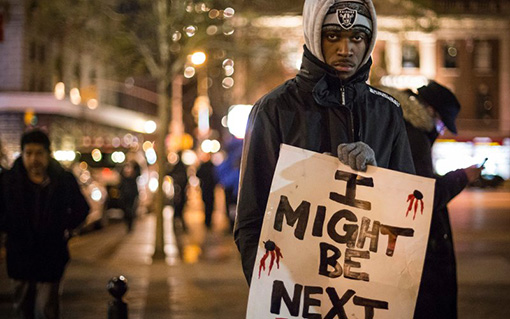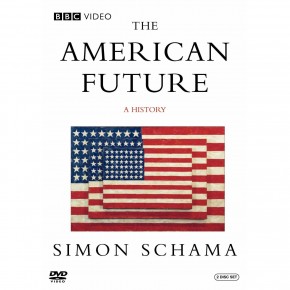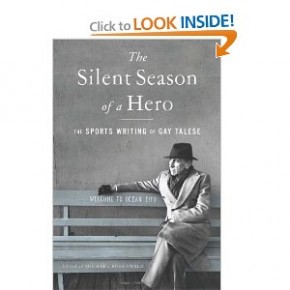The story of a mother, her son, the police who protected them, and the peaceful protest that brought them all together.

Alice Domingues came through the big crowd gathered last Wednesday night at New York City’s Columbus Circle, a container of Starbuck’s hot chocolate in her right hand as she held her son Micah’s hand even more firmly with her left. Earlier in the evening they took the train from the Bronx in order to see the Christmas tree lighting at Rockefeller Center, but were unable to get through police barricades set up at West 50th street, so they walked up Sixth Avenue in order to catch another train home.
“I can’t believe this,” she was saying, her voice hard to hear above the crowd noise.
“The marchers?” she was asked.
“No,” she said. “How much they charge in that place for hot chocolate.”
Alice wore a black nylon rain jacket that looked as if it was ill prepared to deal with the coming chill. She was young, perhaps in her mid twenties and clearly lives in that state of limbo created by the country’s inability to deal with the issue of immigration. Micah is 10 years old and he had a coat geared to the season, a Patagonia winter jacket with a hood.
“Like the hot chocolate, ” his mother said, laughing. “Expensive.”
She and her son had braved the madness within the Starbucks at the corner of Broadway and 60th as she bought a hot chocolate for the boy. She decided on the spur of the moment to join about 500 strangers who were marching north on the broad boulevard, their each step a statement of outrage over the refusal of a Staten Island grand jury to indict a New York City police officer in the sidewalk death of Eric Garner.
He died in July after being grabbed around the throat by a cop and wrestled to ground where the breath flew out of him. He was pinned to the cement for his refusal to go along with an arrest for selling loose cigarettes. The entire scene was caught on tape with a cell phone.
Now, mother and son started to walk. The crowd around them was as diverse as you will find: old, young, white, black, Hispanic, Asian, loud, proud, peaceful and oddly inviting. The reason they were in the street—attracting others to join—was that the grand jury’s act was thought to be so offensive to both common sense and eyesight.
A company of police officers surrounded the floating protesters. They were both in front of and behind the parade of people, making sure the marchers were safe from traffic, blocking off intersections as the peaceful legions proceeded toward Lincoln Center, posing no threat to anyone as they gave voice to a municipal outrage that would soon swell well beyond the borders of New York’s boroughs.
Ironically, the cops moving in the same wave were just as inclusive as the protesters: young, middle-aged, white, black, Asian and Hispanic, their every step non-threatening, their eyes non judgmental.
The New York City police department is more representative of the city it serves than most law firms, university faculties and media companies. According to the latest numbers, the membership of the NYPD is 47 percent white, 17 percent black, 29 percent Hispanic and percent Asian. Within the department there are officers who can speak or understand more than 60 foreign languages. Despite the actions of a flawed few, it is arguably the finest professional police force in the world.
Of course, the big difference between us and them, the eternal divide really, is that police have the power to use three simple words that separate them from any of us: “You’re under arrest.”
Cops can deprive people of their freedom. They are sworn to serve and protect. They work for us and they belong to, basically, a service industry, laboring in conditions that are sometimes threatening, often dangerous yet interesting. Cops, more than firefighters, EMT’s or other public safety employees, almost always get the first glance of the human condition at the worst, most lethal moments; nobody calls a cop with good news. A fire truck roars down a city street and people cheer its arrival. A cruiser shows up and eyes narrow and citizens often withdraw.
Wednesday evening and through the weekend people kept marching. The contagion spread across the country, to Chicago, Boston, Los Angeles and other cities where the fact of no indictment in the death of Eric Garner was thought to be incomprehensible and absurd.
And because of who he was—a black man—and how he died—in the hands of the police—the historical scar of race relations in America once more became the obvious story. Race is the San Andreas Fault of our culture as well as our history. Its fissures are forever present and not that far beneath the surface of every day life. To deny that is to risk being labeled delusional.
White folks can talk or write forever about being black in America without coming close to grasping the sometimes ugly aspects of life for too many back adults and their children. The idea that white commentators can so glibly prattle on about being black is as preposterous as the notion that seeing Saving Private Ryan makes you a combat veteran.
Who is more likely to be eyeballed in a jewelry store? In the aisle of Dick’s Sporting Goods? Waiting in line at an ATM? Walking at night on a quiet city sidewalk? Whose 17-year-old is instructed by a mother or father to keep his or her hands in plain view if a cop pulls them over for a busted tail light?
When he died, Eric Garner was a 43-year-old guy with a lot of health issues and too little money. He held no job. Like so many of the poor, he measured his future by hours and days. How much cash did he need to make it to supper? To the weekend? Before he became a legitimate symbol of suppressed and simmering outrage, he was like so many others among the battalions of poor across this country: a product of a two-tiered education system where the poor, black and white, are too often sentenced to inferior public schools where dreams go to die.
Now, the parade of protesters had reached Lincoln Center and the Wednesday night air was cold and constant and Alice Domingues’ son Micah had finished his cup of expensive hot chocolate. The cops blocked traffic coming down Columbus on to Broadway to let the peaceful march proceed, and Alice Domingues took the boy’s hand and headed toward the subway at West 65th to go uptown to the Bronx.
“How you doin’ kid?” a young policeman asked him, smiling.
“Okay,” the boy replied.
“Merry Christmas,” the cop said to both mother and son, making sure they got through the crowd, watching as they disappeared down the subway steps and toward home.
https://www.thedailybeast.com/articles/2014/12/08/human-moments-at-the-eric-garner-protests.html






